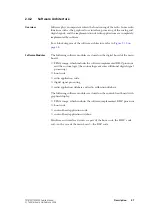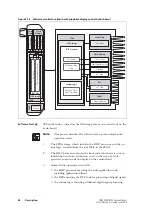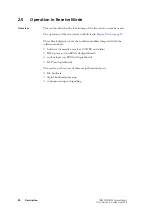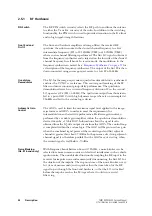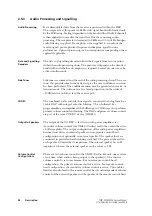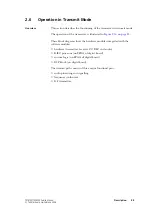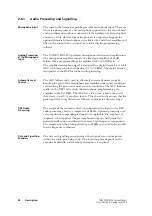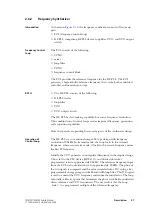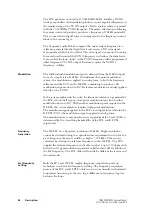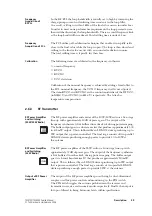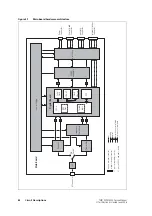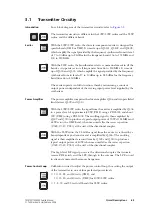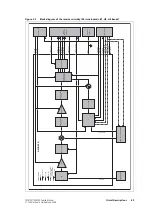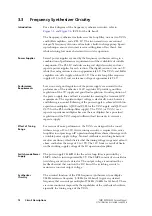
TM8100/TM8200 Service Manual
Description
59
© Tait Electronics Limited
June 2006
Frequency
Acquisition of
RF PLL
In the RF PLL the loop bandwidth is initially set to high by increasing the
charge-pump current and reducing time constants in the loop filter.
As a result, settling to within 1kHz of the final value occurs in under 4ms.
In order to meet noise performance requirements the loop parameters are
then switched to reduce the loop bandwidth. There is a small frequency kick
as the loop bandwidth is reduced. Total settling time is under 4.5ms.
Frequency
Acquisition of FCL
The FCL utilizes self-calibration techniques that enable it to rapidly settle
close to the final value while the loop is open. The loop is then closed and
settling to the final value occurs with an associated reduction in noise.
The total settling time is typically less than 4ms.
Calibration
The following items are calibrated in the frequency synthesizer:
■
nominal frequency
■
KVCO
■
KVCXO
■
VCO deviation.
Calibration of the nominal frequency is achieved by adding a fixed offset to
the FCL nominal frequency; the TCXO frequency itself is not adjusted.
The items KVCO and KVCXO are the control sensitivities of the RF VCO
(in MHz/V) and VCXO (in kHz/V) respectively. The latter has
temperature compensation.
2.6.3
RF Transmitter
RF Power Amplifier
and Switching
(50W/40W Radio)
The RF power amplifier and exciter of the 40W/50W radio is a five-stage
line-up with approximately 40dB of power gain. The output of the
frequency synthesizer is first buffered to reduce kick during power ramping.
The buffer output goes to a discrete exciter that produces approximately 300
to 400mW output. This is followed by an LDMOS driver producing up to
8W output that is power-controlled. The final stage consists of two parallel
LDMOS devices producing enough power to provide 40 to 50W at
the antenna.
RF Power Amplifier
and Switching
(25W Radio)
The RF power amplifier of the 25W radio is a four-stage line-up with
approximately 37dB of power gain. The output of the frequency synthesizer
is first buffered to reduce kick during power ramping. The buffer output
goes to a broad-band exciter IC that produces approximately 200mW
output. This is followed by an LDMOS driver producing up to 2W output
that is power-controlled. The final stage consists of two parallel LDMOS
devices producing enough power to provide 25W at the antenna.
Output of RF Power
Amplifier
The output of the RF power amplifier passes through a dual-directional
coupler, used for power control and monitoring, to the PIN switch.
The PIN switch toggles the antenna path between the receiver and
transmitter in receive and transmit modes respectively. Finally, the output is
low-pass-filtered to bring harmonic levels within specification.
Summary of Contents for TM8235
Page 1: ...TM8100 mobiles TM8200 mobiles Service Manual MMA 00005 04 Issue 4 June 2006...
Page 10: ...10 TM8100 TM8200 Service Manual Tait Electronics Limited June 2006...
Page 62: ...62 Description TM8100 TM8200 Service Manual Tait Electronics Limited June 2006...
Page 148: ...148 Disassembly and Reassembly TM8100 TM8200 Service Manual Tait Electronics Limited June 2006...
Page 162: ...162 Servicing Procedures TM8100 TM8200 Service Manual Tait Electronics Limited June 2006...
Page 178: ...178 Interface Fault Finding TM8100 TM8200 Service Manual Tait Electronics Limited June 2006...
Page 258: ...258 Receiver Fault Finding TM8100 TM8200 Service Manual Tait Electronics Limited June 2006...
Page 446: ...446 Spare Parts TM8100 TM8200 Service Manual Tait Electronics Limited June 2006...



